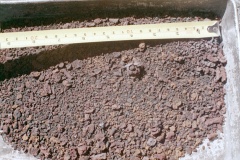Bog Ore
| Infobox on Bog Ore | |
|---|---|
| Example of Bog Ore |  |
| Facts | |
| Origin | See text |
| Stowage factor (in m3/t) | 0,55 m3/t (bulk) |
| Humidity / moisture | - |
| Ventilation | - |
| Risk factors | - |
Bog Ore
Description / Application
Limonite is an iron ore consisting of a mixture of hydrated Iron Oxide-hydroxides in varying composition. Limonite is one of the two principle iron ores, the other being hematite, and has been mined for the production of iron since at least 2500 BCE.
Limonite is named from the Greek word for meadow, in allusion to its occurrence as bog iron ore in meadows and marshes. In its brown form it is sometimes called brown hematite or brown iron ore. In its bright yellow form it sometimes called lemon rock or yellow iron ore.
Limonite is relatively dense with a specific gravity varying from 2.7 to 4.3. It varies in colour from a bright lemony yellow to a drab greyish brown. The streak of limonite on an unglazed porcelain plate is always brownish, a character which distinguishes it from hematite with a red streak, or from magnetite with a black streak. The hardness is variable, but generally in the 4 - 5.5 range.
Although originally defined as a single mineral, limonite is now recognized as a mixture of related hydrated iron oxide minerals, among them goethite, akaganeite, lepidocrocite, and jarosite. Individual minerals in limonite may form crystals, but limonite does not, although specimens may show a fibrous or microcrystalline structure, and limonite often occurs in concretionary forms or in compact and earthy masses; sometimes mammillary, botryoidal, reniform or stalactitic. Because of its amorphous nature, and occurrence in hydrated areas limonite often presents as a clay or mudstone. However there are limonite pseudomorphs after other minerals such as pyrite. This means that chemical weathering transforms the crystals of pyrite into limonite by hydrating the molecules, but the external shape of the pyrite crystal remains. Limonite pseudomorphs have also been formed from other iron oxides, hematite and magnetite; from the carbonate siderite and from iron rich silicates such as almandine garnets.
Limonite usually forms from the hydration of hematite and magnetite, from the oxidation and hydration of iron rich sulfide minerals, and chemical weathering of other iron rich minerals such as olivine, pyroxene, amphibole, and biotite. It is often the major iron component in lateritic soils. It is often deposited in run-off streams from mining operations.
One of the first uses was as a pigment. The yellow form produced yellow ochre for which Cyprus was famous, while the darker forms produced more earthy tones. Roasting the limonite changed it partially to hematite, producing red ochres, burnt umbers and siennas. It is sometimes used for the adsorption of sulphur vapour, after which it becomes hazardous cargo and should receive special treatment before shipment.
Bog iron ore and limonite mudstones are mined as a source of iron, although commercial mining of them has ceased in the United States.
Iron caps or gossans of siliceous iron oxide typically form as the result of intensive oxidation of sulfide ore deposits. These gossans were used by prospectors as guides to buried ore. In addition the oxidation of those sulfide deposits which contained gold, often resulted in the concentration of gold in the iron oxide and quartz of the gossans. Goldbearing limonite gossans were productively mined in the Shasta County, California mining district. Similar deposits were mined near Rio Tinto in Spain and Mount Morgan in Australia. In the Dahlonega gold belt in Lumpkin County, Georgia gold was mined from limonite-rich lateritic or saprolite soil. The gold of the primary veins was concentrated into the limonites of the deeply weathered rocks. In another example the deeply weathered iron formations of Brazil served to concentrate gold with the limonite of the resulting soils.
Shipment / Storage / Risk factors
See Ores for overseas shipment/storage.











